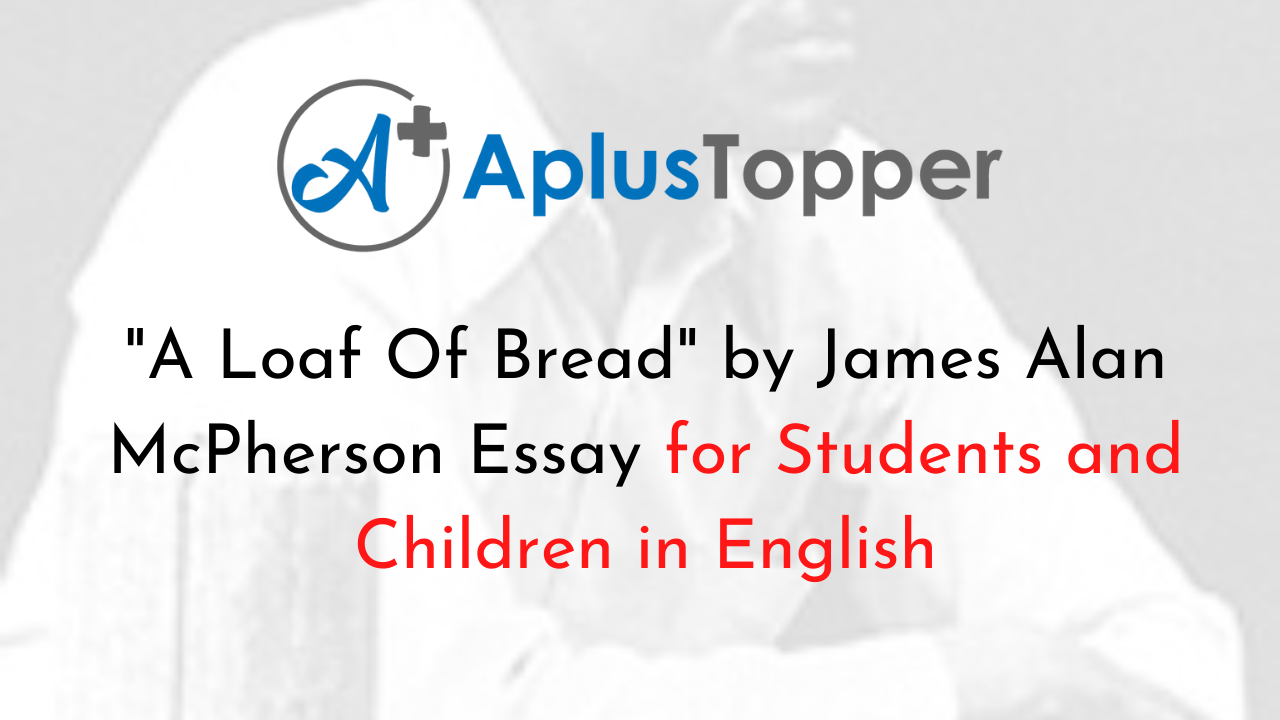“A Loaf Of Bread “James Alan McPherson Essay: A Loaf Of Bread James Alan McPherson: “A Loaf Of Bread” tells the story of two men on opposite sides of a dissent picket. Here, Harold Green is the reason for the story to be narrated and Nelson is the impact. McPherson worked very hard to show each of their perspectives.
This is generally obvious in the end scene. It initially gives the idea that Harold’s choice to free his staple up to the local area is his recovery. However, it’s anything but. Not in the slightest degree. It ends up being Nelson’s recovery, in an astounding and dignified piece of plotting. Also, that is a significant stunt on McPherson’s part.
You can read more Essay Writing about articles, events, people, sports, technology many more.
James Alan McPherson “ A Loaf of Bread”
“A Loaf of Bread ” by James Alan McPherson is a tale of Harold Green who is blamed for making fools of customers because of his overrated items being sold at one of his stores. All through the story, Green is confronted with a plenty of various snags that he needs to defeat to demonstrate not exclusively to his family, yet to himself that he is a genuine and caring man.
There are a wide range of exercises and topics you can choose from this story, yet one specifically that I feel is significant is the connection between Harold Green and Nelson Reed.
The two men, Harold and Nelson, are presented as direct inverses of one another, however as the story moves forward, the two of them find that they are a lot of the same and the hostility they once shared was just a simple misconception. Before the finish of the story, the two of them gain so much from one another and that passing judgment on somebody without knowing their position or seeing things according to their viewpoint can regularly prompt wrong decisions.
“I haven’t invented this world,” he rehashed. “I just developed it” This statement impeccably depicts Harold Green and his point of view on life. In the start of the story, Green is presented as a self centered yet genuine man. He realized that he was cheating clients in his store, yet to him it was something he needed to do to accommodate his family regardless of whether it implied losing them.
“What is the color of these individuals?” he inquired.
His wife said: ” Black COlor,”
“Now, what is the name of our kids?”
“Green.”
Harold smiled and said: “There you go! Green is the color I love the most.”
This moreover shows that Green gets going as a narrow-minded man. He decided to disregard the necessities of his clients because of his desire for cash. Nelson Reed then again, was presented as a glad and caring Christian man. He accepted that what Green was doing wasn’t right, and wanted to support his kin.
Albeit the two men appear to be direct inverses of one another, they actually had comparable attributes. They were both difficult and resolved to support what they have confidence in. Green from the outset, didn’t have any desire to yield to his significant other and part with his items free of charge. He declined in light of the fact that he accepted he was correct, and that he expected to go to bat for himself. Reed, albeit not quite the same as Green, shared a comparable point of view about the entire circumstance. He wanted to support himself and his kin. As the two characters progress, the two of them settle on a certain something; cash runs the world.
“The most important thing in the world is money.” This statement by Reed portrays a superior comprehension between the two. Reed is at long last beginning to see things through Green’s eyes and understands that he would’ve done likewise as Green in the event that he had owed the store.
“Just think of yourself in my place. Say on a benefit size of fifteen to 40%, when in the middle would you take a stand?” “Forty? Possibly 45 or fifty?” the merchant took in Reed’s ear. “In the grocery stores, you know, they have more inconspicuous methods of achieving such accomplishments.” Reed slapped his espresso mug with the rear of his right hand. The earthy-colored fluid twirled across the ledge, wetting the books. “Damn this!” he yelled.”
Despite the fact that Reed is hesitant to accept he resembles Green, he is currently imagining Green’s perspective. As it were, it’s practically similar to how Reed is yielding to himself. Green does likewise. One morning Green chooses to surrender to himself and give out his items free of charge.
Eventually, as Green is highly involved with giving out things, Reed strolls in and demands that he pay for the portion of bread his better half had taken free of charge before.
“I think it was brown bread. Is it not costlier than white bread?”
“In my store, yes,” Green said.
He rang the register with the most relaxed development of his finger. The register read 55 pennies. Nelson Reed held out a dollar.
“Moreover, two cents tax on it” the merchant said. The man held out the dollar. “All things considered,” Harold Green said. “We are all, all things considered, Mr. Reed, owing debtors to the public authority.” This last statement from the story summarizes the change we see in the two characters. Green has now discovered that there is a whole other world to life than just cash and himself, while Reed figures out how to regard Green’s calling. The way that Reed followed through on full cost for the bread shows that he comprehends Green’s situation as opposed to the starting where he considered it’s anything but wrongdoing how Green had overrated his things. Eventually, the two men had learned important exercises, and in spite of the fact that from the start were altogether different and contradicting one another, settled that they are close to two comparative individuals bringing in cash for the public authority.

FAQ’s on “A Loaf Of Bread” by James Alan McPherson Essay
Question 1.
The story of A loaf of bread was based on whom?
Answer:
The story of A loaf of bread was based on a man whose name was Harold Green. He was found guilty of cheating his customers by selling the products overpriced.
Question 2.
Who gave the story of A loaf of bread?
Answer:
The story of ‘A loaf of bread is given by James Alan McPherson.
Question 3.
What are the themes of the story ‘A loaf of bread’?
Answer:
The main themes of the story ‘A loaf of bread’ were pride and overcoming selfishness with selflessness.
